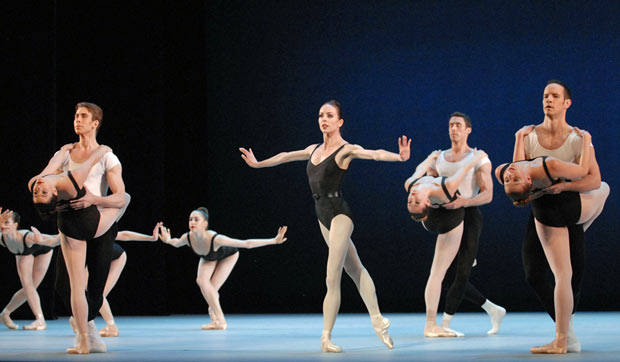
© Linda Spillers. (Click image for larger version)
Ballet Across America III
Sarasota Ballet: Les Patineurs
Washington Ballet: Wunderland
Pennsylvania Ballet: Four Temperaments
Washington, Kennedy Center Opera House
6 June 2013
www.kennedy-center.org
www.sarasotaballet.org
www.washingtonballet.org
www.paballet.org
First and foremost, Ballet Across America is about discovery. This week-long ballet sampler, hosted by the Kennedy Center and featuring nine ballet companies from various regions of the United States, brings the great opportunity for audiences and critics alike to discover something new about American ballet with each of the festival’s three diverse triple-bill programs.
I am happy to report that the biggest discovery of the second program was The Sarasota Ballet, a company founded in 1991 and currently directed by former Royal Ballet dancer Iain Webb. Who knew that a small troupe from Florida, operating on a tiny budget, would become America’s major repository of the ballets created by the most important British choreographer of the 20th-century, Sir Frederick Ashton?
Since his arrival in 2007, Webb has added to the company’s repertory nine Ashton works. The upcoming season will feature two more premiers (Les Illuminations and Sinfonietta); and several Ashton revivals will be performed during The Sarasota Ballet’s “Sir Frederick Ashton Festival,” which will take place in early May of next year, commemorating the 25th anniversary of the choreographer’s death.

© Linda Spillers. (Click image for larger version)
At the Kennedy Center the company presented Ashton’s 1937 magical and lighthearted Les Patineurs. A delightful evocation of ice-skating in a Victorian wintry park, this ballet is a real charmer. Its subject matter may seem trivial, but its choreographic craft and invention are immense. When Ashton created this piece for the Vic-Wells Ballet (which would later become the Royal Ballet), he knew virtually nothing about skating and had never seen an ice-skating rink in his life. His picturesque choreography in Les Patineurs, however, convincingly depicts the joys and perils of gliding on ice skates. Here the classical ballet steps are made to look like skating movements to astonishing effect.
The gorgeous sets, originally designed by William Chappell, suggest a 19th-century park. The stage is adorned with white arched trellises and colorful glowing lanterns, all enveloped by a shadowy forest; and the special floor and lighting create a spectacular illusion of ice. The ballet’s music – an arrangement of two operatic works by the French composer Giacomo Meyerbeer – is perfectly joyful and buoyant, an ideal soundtrack for a skating party.
The hugely talented cast of The Sarasota Ballet demonstrated both impeccable virtuosity and profound fluency in Ashton’s unique style of dancing. Dressed to impress, the ensemble of four couples and assorted soloists brought to the fore the fascinating interplay of human feelings which the choreographer so artfully embedded in this enchanting dance.
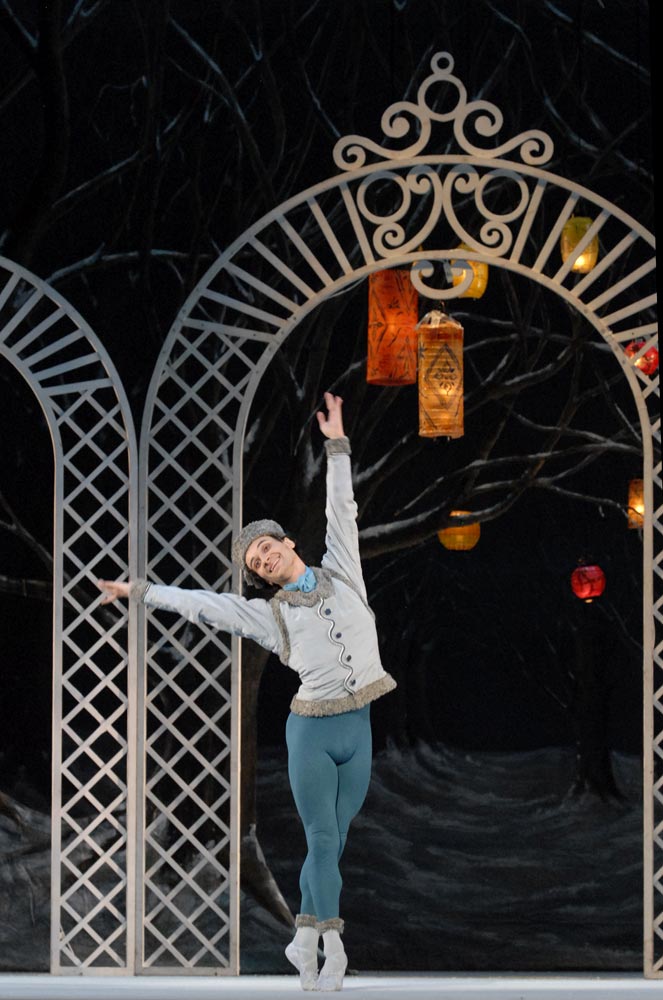
© Linda Spillers. (Click image for larger version)
The sprightly and jolly Logan Learned was the ballet’s centerpiece and its bright star as Blue Boy. His dancing exuded both lively spirit and utter charm. Kate Honea and Nicole Padilla delivered a thrilling account of the Blue Girls’ duet; and the elegant Danielle Brown and Ricardo Graziano brought a special majestic appeal to the White Couple pas de deux.
The Washington Ballet continued the program with Wunderland, a ballet created for the company in 2009 by the Chinese-born choreographer and former dancer of the New York City Ballet, Edwaard Liang. Set to the chamber and piano music of Philip Glass, Wunderland is a visually attractive, yet somewhat incoherent piece, with a little too much melodrama for my taste. For the most part, the choreography is slick, fast-paced and technically arduous, allowing the dancers to show off their powerful skills, superb articulation and stamina; the ballet’s movement vocabulary and stylistic flourishes underscore Liang’s NYCB pedigree. Speedy footwork, sky-high extensions and intriguing partnering – Wunderland has all these in spades. Yet, for all its visual allure and technical bravura, the piece left me emotionally unmoved. The choreography often felt too heavy and overdone; and the ensemble numbers offered little innovation or excitement.
The pillars of this Wunderland are two contrasting duets. The first, thorny and intense, comes across as a battle of wills. (It was danced to the hilt by the excellent Maki Onuki and Luis R. Torres.) The second pas de deux, in contrast, has a calm and subtle nature. It’s set to the serene and melancholic piano piece “Metamorphosis II.” The music, with its rolling and repetitive passages, creates an atmospheric soundscape as well as a perfect canvas for the lovelorn couple (Sona Kharatian and Jared Nelson) to depict what seems like the uncertainties and heartbreaks of their romantic journey.
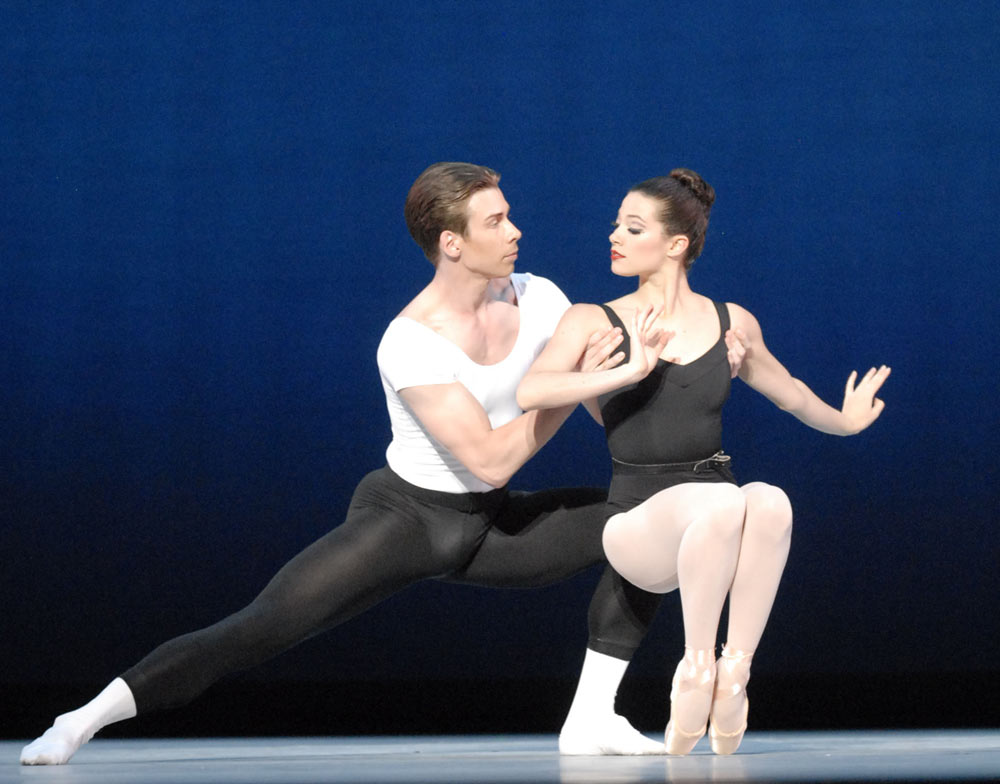
© Linda Spillers. (Click image for larger version)
George Balanchine’s classic The Four Temperaments by The Pennsylvania Ballet concluded the evening. The Four Temperaments is one of Balanchine’s earliest masterpieces – the ballet is nearly 70 years old. It was created to a commissioned score by the German composer Paul Hindemith. Titled “Theme with Four Variations for String Orchestra and Piano,” the music vaguely alludes to the four temperaments which the ancient Greeks believed formed the human personality. Just like Hindemith, Balanchine took the Greek notion of the temperaments as “the point of departure” in his creative process and made an abstract dance in which the classical ballet steps took a completely novel and unconventional look. With its inverted and angular movements and asymmetrical and shifting patterns, The Four Temperaments marked the new American ballet style.
Shaped and chiseled by the music’s structure and flow, the ballet is divided into five parts. The opening movement consists of three themes, each danced by a soloist couple. Then follow four distinctive musical and choreographic variations, corresponding to the four types of human personality: Melancholic, Sanguine, Phlegmatic and Choleric – all capped by an exalting finale for the entire ensemble.
The Pennsylvania Ballet’s outstanding cast was fully up to the technical challenges of Balanchine’s choreography. The soloist dancers, without exception, were admirably musical and clean in style. Amy Aldridge particularly made an impression in the role of Choleric, dancing with cool authority and inspiration; and the performance of Jermel Johnson in the Phlegmatic role was, in a word, brilliant.















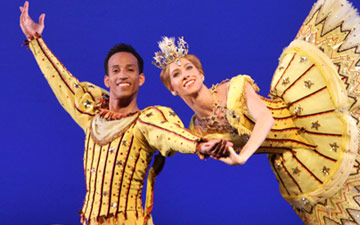
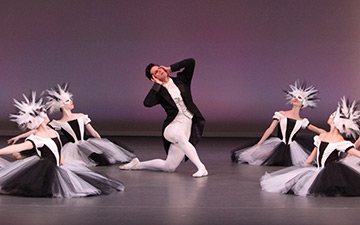
You must be logged in to post a comment.